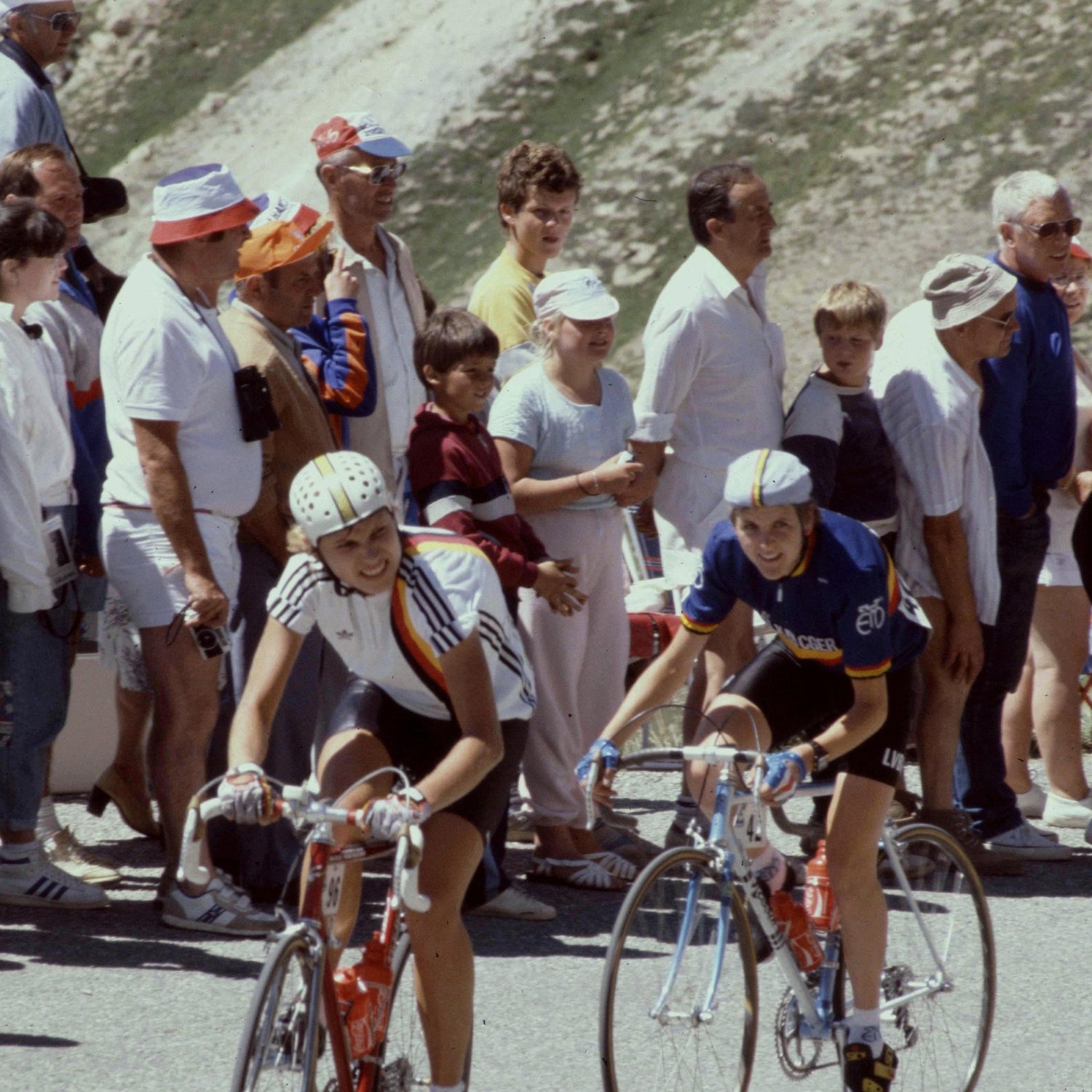Four years ago on a sunny July day in Paris, former pro cyclist Kathryn Bertine wheeled up to the starting line of La Course by Le Tour de France. She still remembers feeling the energy on the Champs Élysées��that day and hearing the scrape of cleats on cobblestones. She’d spent years negotiating, petitioning, and organizing to bring about the event and finally she’d arrived, along with a roster��of the best women cyclists in the world.��
La Course was the latest attempt in a decades-long fight to create a lasting, prestigious women’s stage race to run alongside the Tour de France. Such events have come and gone through the decades, beset by financial struggles, organizational roadblocks, lack of media coverage, and good old-fashioned sexism. But Bertine thought that this time, she could make it stick.��
The first attempt at a women’s Tour took place in 1955, when 41 women competed in the five-day , put on��by French journalist and race director Jean Leulliot. Despite mockery from the press and photographers, who allegedly tried to surprise competitors in their dormitories, the women finished the race. But without stable financial backing, the race disappeared��the following��year.
The Tour de France Féminin returned in 1984, this time organized by the group behind the men’s��Tour de France. The idea was to create a truly equal event: during the three-week tour, women rode the same routes as their male counterparts, albeit slightly shortened to ensure they finished ahead of the men’s peloton. But a��lack of prime-time attention hurt the race: cycling publications largely ignored the women. After two years of a full-length tour, organizers cut the Tour de France Féminin down to two weeks.
By that point, the business of professional cycling had started to change dramatically. TV coverage of the Tour de France increased, turning sponsorships and ads into a lucrative business. In 1989, the Tour organizers dropped the women’s race entirely in order to capitalize on the much larger men’s audience. “We could have been watching women since 1989,” says Bertine. “But instead they sold the TV rights for the men and got rid of the women.”
The events have come and gone through the decades, beset by financial struggles, organizational roadblocks, lack of media coverage, and good old-fashioned sexism.
There were other attempts from other organizers: the Tour de l’Aude Cycliste Féminin, a women’s stage race held in south-central France that was founded in 1985��as a four-day event��and grew into a multi-day tour that by 2006 had ten stages; the 1992��La Grand Boucle Féminin��Internationale (so named��because organizers of the Tour de France prohibited any reference to “the Tour” on the grounds of trademark infringement), which lasted for 12 years and linked epic stages; the 2004 Grand Boucle Féminin, which lasted till 2010; and the 2006 Route de France Féminine, which became one of France’s most prestigious women’s races until it was��canceled in 2017 due to a scheduling conflict and the UCI’s decision not to give the race WorldTour status.��
Over and over again, the same fatal cycle��repeated itself: Without robust media coverage, the audience wasn’t big enough to attract sponsors to fund big events. Without big events, no sponsors were interested. After all, people can’t want what they cannot see—nor can advertisers buy it.
That was��the problem La Course, which was the result of years of lobbying the UCI,��sought to address. It would piggyback on the infrastructure and media attention of the Tour de France. Live on 24 channels, the race was watched by millions of viewers in at least 150 countries. Dutch phenom Marianne Vos��would go on to sprint for the win and earn part of the $30,500 purse—a prize equal to the amount men receive for winning just one��stage of the Tour.
Lots of people hailed La Course as a massive step forward for women’s cycling. But critics called it a token event��to quell the increasingly vocal complaints about gender inequality in cycling. It was only a one-day race instead of a multi-day tour—a curtain raiser for the men, who were still very much the main event, they said. The 55-mile race lasted just over two hours and covered 2.5 percent of the Tour de France course.
“We intended the race initially be three to seven days the first year, and it would grow incrementally from there as the financial structure of women’s cycling grew,” says Bertine. “We saw it as getting our foot in the door.”
The UCI, the sport’s international governing body, seemed to echo this thought. “Our job now,” , then newly minted president of the UCI, in 2014 “is…to make sure that women’s road cycling develops in a way that is sustainable, that builds on each successive step with another successful step.”
That never happened. After repeating the one-day event on the Champs-Elysees in 2015 and 2016, the Amaury Sports Organization (ASO), which puts on the Tour de France, added a second day to La Course in 2017. But the format changed. Day one was a mountain stage, a climb to the Col d’Izoard—the men’s final mountain stage in the Tour. But while the men rode 103 miles, the women’s stage was a paltry 41. And only the top 20 finishers��of this stage were allowed to participate in day two, an unorthodox pursuit-style individual time trial. “If you follow cycling, that’s ridiculous!” Bertine says. “Why would you take the top 20 climbers and put them in a time trial? It’s a totally different event. It was a show pony event.”
The disappointment was evident. “We took it as seriously as��we felt the organizers took us,” sats��British rider Lizzie Deignan, who pointed out that she couldn’t even find a women’s toilet at the race start. “To warm up for a time trial not knowing where the closest bathroom is—if there is one at all—It’s difficult to take that seriously.” Retired German cyclist Judith Arndt, two-time winner of the Tour de l’Aude, was more blunt. She called the new format “pathetic and humiliating.”
“If we want to rise above the inequality, it’s the women who have to rise up together and say, ‘No more. This is not okay. I deserve exactly what the men have.’ ”
This year, the event was once again shortened. The one-day race was another truncated version of the men’s Stage 10 of the Tour de France, a 159 kilometer��ascent in the Alps with four major climbs. La Course covered 118 kilometers��of that route, omitting two of the four climbs.
“I did get the feeling from ASO that they were annoyed by the hassle of having to deal with women wanting a race and then having to arrange a women’s race,” British World Champion Emma Pooley told VeloNews. She pointed to the OVO �´dz����’s Tour, a five-day, 650-kilometer��women’s stage race in the United Kingdom as a model that shows the audience does exist for women’s events. VeloNews reported that the 2017 race, according to organizers, attracted 500,000 spectators and 1.4 million UK TV viewers.
At this year’s La Course, the women delivered a thrilling show with a hold-your-breath ending. After a high-speed descent from the Col de la Colombiere, Anna van der Breggen, the Dutch Olympic gold medalist who won the women’s road race at the 2016 Games in Rio de Janeiro, appeared to have won the race. Then, in the final 300 meters, fellow Dutchwoman Annemiek van Vleuten (who led the race in Rio before a horrific crash that knocked her out cold) began closing the gap. Just 50 meters from the finish line, van Vleuten passed van der Breggan, winning La Course by one second.
It was yet another reminder of how exciting women’s pro cycling can be. And yet, the live TV coverage in the United States was a joke wrapped in an insult and deep-fried in indignity. “Only the last kilometer was televised,” Bertine says. “In the States, the only way to see the whole race was to buy a subscription to NBC Sports Gold [a stand-alone online streaming service for $49.99. Why do we have to pay 50 bucks to see the women?”
“If we want to rise above the inequality, it’s the women who have to rise up together and say, ‘No more. This is not okay. I deserve exactly what the men have,’” she says. “Standing on that start line [in 2014] gave me the hope that yes, we have the power to effect change. You know, I’m not famous. I’m not wealthy. I’m not an Olympic medalist. But if I helped make this happen, then we all have the power to make change happen.”


